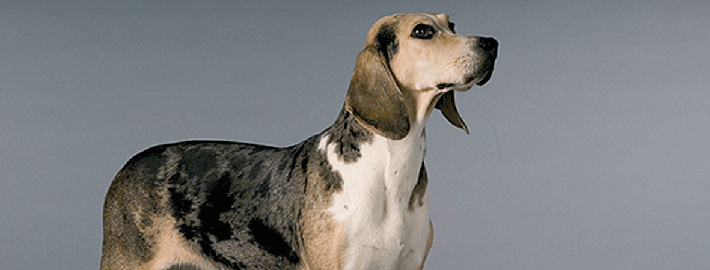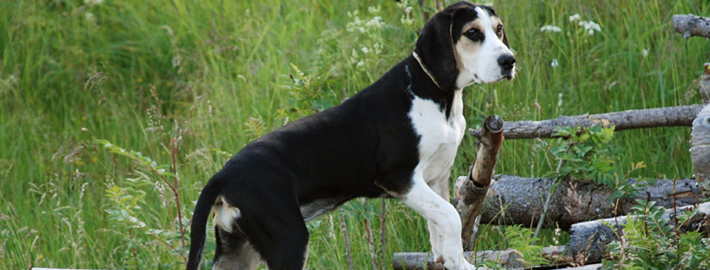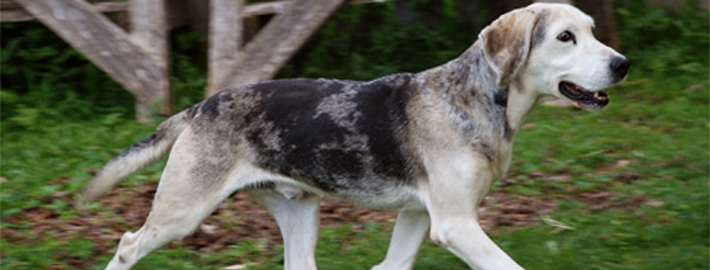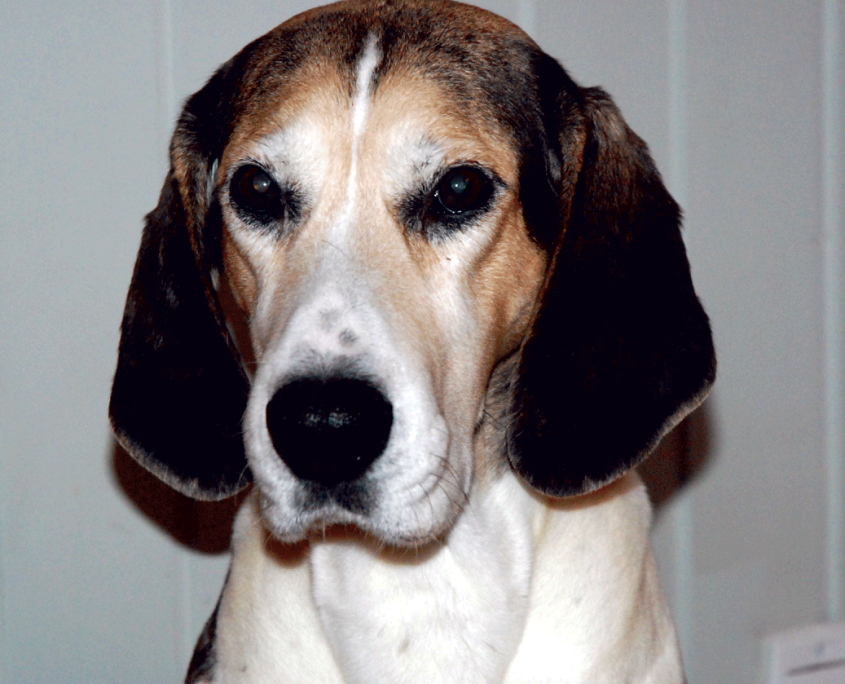What makes the Dunker Unique?
The breed is named after the Norwegian Wilhelm Dunker, who bred this dog for hunting hares at the beginning of the 19th century. To create the Dunker, Wilhelm crossed a Russian Harlequin Hound with reliable scent hounds, producing a dog that could hunt rabbits by scent, rather than sight.
Breed Groups
Page Contents
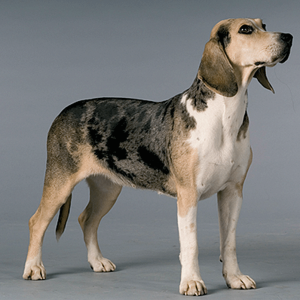
SnapShot
| Size: | Males – 50 to 55 cm (19.5 to 21.5 inches) Females – 47 to 52 cm (18.5 to 20.5 inches) |
| Weight: | Males – 11 to 18 kg (25 to 39 pounds) Females – 11 to 18 kg (25 to 39 pounds) |
| Origin: | Norway |
| Life Span: | 12 – 15 Years |
| Colour: | Black or blue marbled with pale fawn and white markings is most desirable |
| Litter Size: | up to 10 puppies |
Is the Dunker Right For You?
Like most scenthounds, the Dunker was bred to be tolerant of strange hunters and handlers. This breed is usually non-aggressive, and when properly trained and socialized, most breed members are quite friendly. The Dunker lacks the aggression to make an effective guard dog, and most of these dogs would follow a stranger home before they would show them aggression. Dunkers are known to be very affectionate dogs, many of them fawningly so.
The Dunker is an independent breed and may not be easy to train. It will need a firm and consistent trainer who is ready to put in time and effort to train this dog. The dog needs a firm and confident trainer.
In 5 Words
- Alert
- Energetic
- Tenacious
- Responsive
- Intelligent
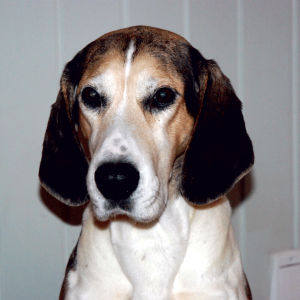
Characteristics
Learn About the Dunker
Description
The Dunker has a clean, noble, long head with parallel planes of the skull and muzzle, carried low and not wedge-shaped. Its skull is slightly domed with a defined stop and clean cheeks, the muzzle is long and square-cut with a straight and broad nasal bridge, and its teeth are evenly spaced with a scissors bite.
Dunker dog is a medium-sized strong structured dog with a well-balanced temperament and gentle manners. Their fairly large eyes are dark-coloured and feature a tranquil expression. These dogs have flat ears that are thin, soft, and long, with rounded tips. Their ears are carried close to their head, with a muzzle that is narrow and long.
The Dunker is very similar in appearance to other medium-sized scenthounds, but is easily distinguished by its unique coat coloration. The Dunker is the epitome of a medium-sized scenthound breed. Most males stand between 19½ and 21½ inches tall at the shoulder, and most females stand between 18½ and 20½ inches tall at the shoulder.
Short History of the Dunker
Dunker dog breed was named after Wilhelm Dunker., who bred this dog for hunting hares at the beginning of the 19th century. To create the Dunker, Wilhelm crossed a Russian Harlequin Hound with reliable scent hounds, producing a dog that could hunt rabbits by scent, rather than sight. It has yet to become popular outside of its homeland. He crossed an Anglo-Russian Hound (Harlequin Hound) with indigenous dogs, which resulted in a Dunker. The Dunker is a relatively recently created breed, and we know more about its ancestry than is the case with many dogs. As is the case with breeds such as the German Shepherd Dog and the Doberman Pinscher, the Dunker is largely the result of one man’s breeding efforts.
Temperament
This is quite a friendly and relaxed breed. It will provide these traits only to owners who will offer lots of activity. Dunker dog is a friendly, relaxed, kind and even-tempered breed. The breed gets along well with kids, especially if socialized from a young age. Due to its robust and energetic nature, the dog can adapt well to different kinds of terrain. Dunkers are even-tempered, friendly, and kind. Although they are good hunters, they also make great family pets.
Like most scenthounds, the Dunker was bred to be tolerant of strange hunters and handlers.
Caring for Your Dunker
Grooming & Bathing
There are many benefits to owning a Dunker, such as its no hassle, low maintenance coat. The coat of these dogs is easy to groom and maintain. Owners should just brush the coat of these dogs regularly. Dunkers do shed, and they can shed very, very heavily. This is a breed that will cover carpets, furniture, and clothing with dog hair all year long and would probably drive a neat freak or allergy sufferer crazy.
Exercise & Training
The Dunker is a natural hunter and takes to hunt training very easily. However, this breed presents substantial training difficulties in other areas. The same traits that make scenthounds excellent hunters, stubbornness, determination, independent thinking, also makes them very challenging to train. Most breed members are very stubborn, and many are outright disobedient. This does not mean that it is impossible to train a Dunker, but it does mean that Dunker owners will have to spend significantly more time, effort, and patience than would be the case with most breeds. Dunkers are driven to follow any scent trail which they encounter, and even well-trained breed members are likely to ignore any calls to return when on the hunt. For this reason, Dunkers should always be kept on a leash when outside of a safely enclosed area.

